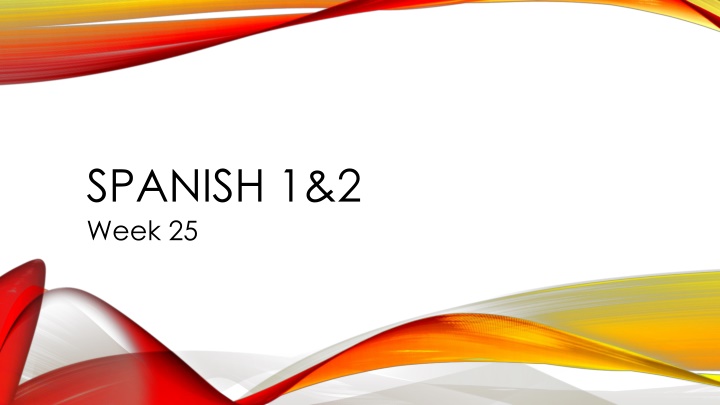
Spanish Direct and Indirect Object Pronouns Study Guide
Enhance your understanding of direct and indirect object pronouns in Spanish with this study guide. Practice conjugations, prepositions, and identifying masculine and feminine nouns.
Download Presentation

Please find below an Image/Link to download the presentation.
The content on the website is provided AS IS for your information and personal use only. It may not be sold, licensed, or shared on other websites without obtaining consent from the author. If you encounter any issues during the download, it is possible that the publisher has removed the file from their server.
You are allowed to download the files provided on this website for personal or commercial use, subject to the condition that they are used lawfully. All files are the property of their respective owners.
The content on the website is provided AS IS for your information and personal use only. It may not be sold, licensed, or shared on other websites without obtaining consent from the author.
E N D
Presentation Transcript
SPANISH 1&2 Week 25
Lunes el seis de febrero Spanish 1: Write 10 activities that people have to do in this way: I have to . We have to She has to . He has to They have to .. You have to . Yo tengo que cortar el c sped. Help Sheet conjugate Tener page 58 Person + tener + que + infinitive chore Play Quizlet for tener + que and prepositions
lunes el seis de febrero write the following into your Notes Spanish 2 : write the direct object pronoun equivalents singular plural me= us= you informal= you informal= you formal, him, it= you, them masculine= you formal, her, it= you, them feminine= Spanish 2: play direct object pronoun Quizlet vmercado72
Spanish 2 Notes Pronouns=replaces a noun Noun= person, place or thing Kawanza=She Subject pronouns=I , he ,she ,we, they, it They initiate the action(verb) Object pronouns=me, her, him, us, them, it Direct objects answer the question Who or What Indirect object pronouns answer the question For Whom or For What
martes el siete de febrero Spanish 1&2 translate the following: 1. Stand to the right of your desk. 2. Stand to the left of your desk. 3. Stand behind your desk. 4. Stand in front of your desk. 5. Sit on top of your desk. 6. Stand on your chair. Spanish 1: Students will take the preposition test Spanish 2: Students play indirect object Quizlet.
1. Prate a la derecho de t escritorio. 2. P rate a la izquierda de t escritorio. 3. P rate detras de t escritorio. 4. P rate en frente de t escritorio. 5. Si ntate encima de t escritorio. 6. P rate en t silla. Indirect object pronouns page 106
Spanish 2 on the test you can have a help sheet with the direct object chart on page 98 and the indirect object chart on page 106 Tell whether the following are masculine or feminine Dedos m p agua s m juego carro caja rodilla Galletas Puerta
Indirect object pronouns He bought a gift for her. DO = answers who or what IO= answers for whom or for what The word that follows the subject is the indirect object She bought shoes. Ella compr zapatos. Los______ compr en el mol. A vosotros ____ gusta mirar television.____ miramos en la sala.
miercoles el ocho de febrero Watch youtube video on The Dominican Republic https://www.youtube.com/watch?v=dQv3t5VCc3U = the Dominica Republic Spanish 1&2 : Write 10 facts about the DR Spanish 2: Student s will take the direct objects test
Spanish 1&2 Make up test ticket to test If you wish to make up your preposition test or your Direct object / Indirect object Test you have to make a set of flash cards with pictures and have your parent or guardian sign off on the fact that they quizzed you.
Miercoles el ocho de febrero Spanish 1: write the following into your notes hay + noun = there is/ are no hay + noun= there is not/ are not Write 10 questions and responses in the following format. Hay pan? Si, hay. Hay mantequilla? No, no hay Hay helado? Hay leche? Hay papel? Hay ? ?
jueves el nueve de febrero Lab day Spanish 1&2 Fans on-line due counts as a summative One note assignments due Students will begin unit three Fans On-line
Viernes el diez de febrero watch the youtube video about Cuba https://www.youtube.com/watch?v=iQnhoYc2QTg = Cuba Write 10 facts about Cuba Spanish 1: using your notes on hay + noun = there is/ are and no hay + noun= there is not/ are not Students will write 10 sentences using no hay . pero si hay .. No hay pollo pero si hay jam n
viernes el diez de febrero Spanish 2: write a sentence with each of the demonstratives in the chart on page 128 (15) Write them in Spanish and English. Then make a Quizlet.
